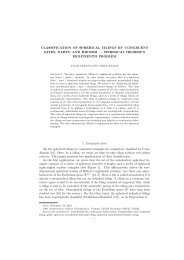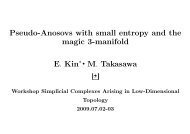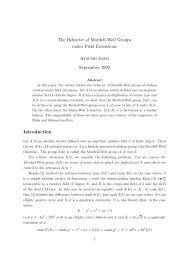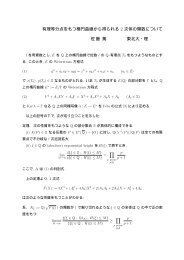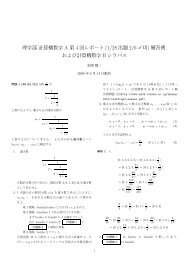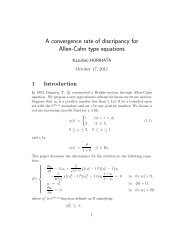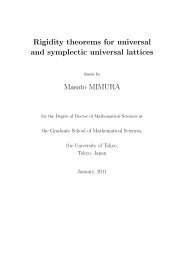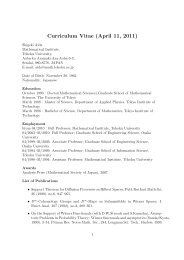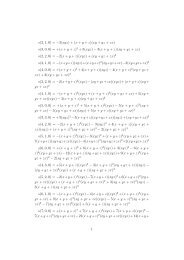Constructions of harmonic maps between Hadamard manifolds
Constructions of harmonic maps between Hadamard manifolds
Constructions of harmonic maps between Hadamard manifolds
Create successful ePaper yourself
Turn your PDF publications into a flip-book with our unique Google optimized e-Paper software.
4.2. A COUNTER EXAMPLE 79<br />
where (y, η, ξ, x) ∈ R + × R 3 and (Y,X) ∈ R + × R. Note that the vector field ∂/∂x is<br />
mapped to the vector field ∂/∂y via the complex structure <strong>of</strong> CH 2 . Let Φ : B 2 → CH 2 and<br />
Ψ:D 2 → RH 2 be the Cayley transforms <strong>of</strong> CH 2 and RH 2 , respectively. Assume that a<br />
map ũ : CH 2 → RH 2 takes the following form:<br />
ũ(y, η, ξ, x) =(f(y),g(x)).<br />
Then the <strong>harmonic</strong> map equation for ũ is reduced to the following system <strong>of</strong> ordinary differential<br />
equations:<br />
⎧<br />
⎪⎨ 4y 2 f yy (y) − 4yf y (y) − y 2 f(y) −1 {4f y (y) 2 − g x (x) 2 } =0,<br />
⎪⎩ g xx (x) =0,<br />
where f y = df/dy, f yy = d 2 f/dy 2 ,g x = dg/dx, g xx = d 2 g/dx 2 .<br />
For any a, b ∈ R, we can easily verify that f(y) =(|a|/2 √ 2)y and g(x) =ax + b are<br />
solutions to this system. Therefore we obtain a family <strong>of</strong> <strong>harmonic</strong> <strong>maps</strong><br />
Let ⎧⎪ ⎨<br />
⎪ ⎩<br />
˜σ (a,b) (y, x) =<br />
ũ (a,b) : CH 2 ∋ (y, η, ξ, x) ↦→<br />
( |a|<br />
2 √ 2 y, ax + b )<br />
∈ RH 2 .<br />
( |a|<br />
2 √ 2 y, a<br />
2 √ 2 x + b )<br />
: RH 2 → RH 2 ,<br />
σ (a,b) =Ψ −1 ◦ ˜σ (a,b) ◦ Ψ:D 2 → D 2 ,<br />
ũ(y, η, ξ, x) =ũ (2<br />
√<br />
2,0) (y, η, ξ, x) =(y, 2 √ 2x) :CH 2 → RH 2 ,<br />
u (a,b) =Ψ −1 ◦ ũ (a,b) ◦ Φ:B 2 → D 2 .<br />
Note that, if a ≠0, each u (a,b) is smooth up to the boundary except for (0, 1) ∈ ∂B 2 . Thus<br />
we need to investigate the boundary behavior <strong>of</strong> u (a,b) near the point (0, 1). To this end, since<br />
any σ (a,b) is an isometry <strong>of</strong> D 2 which fixes the point (0, 1) commonly, it suffices to consider<br />
the case where a =2 √ 2 and b =0. Set u =Ψ −1 ◦ ũ<br />
√<br />
(2 2,0)<br />
◦ Φ.



